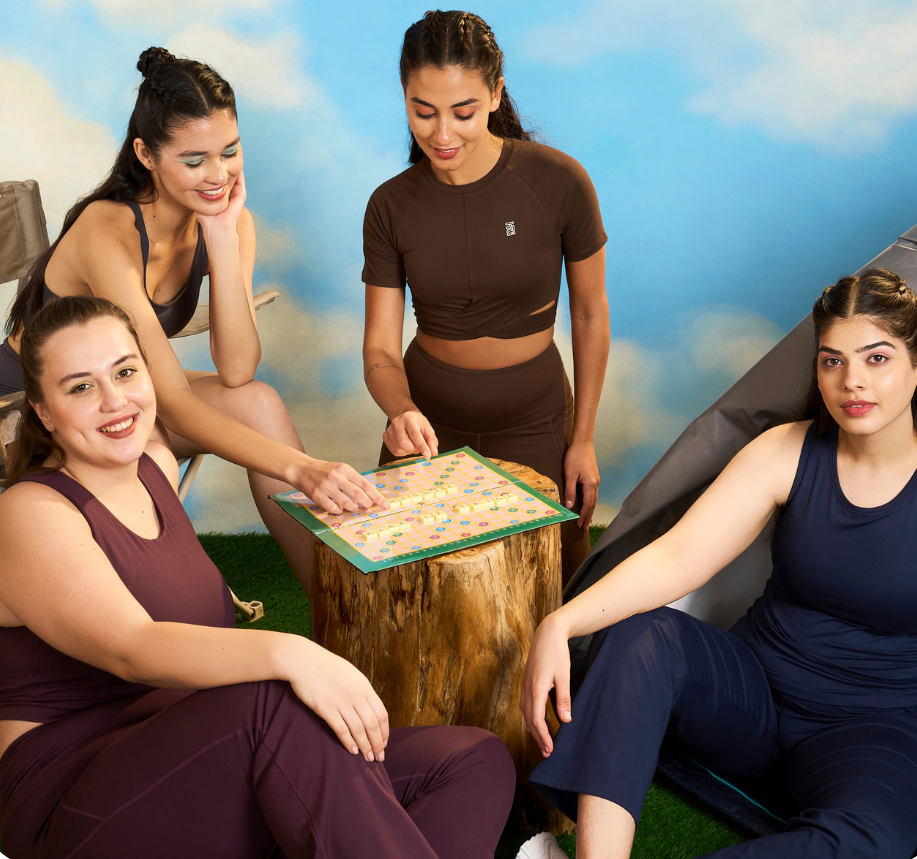Rainy Days, No Excuses: Best Home Workouts Without Equipment to Stay Fit This Monsoon
Monsoon season often affects workout motivation, and you're not alone in feeling this way. Rainy days naturally create lethargy and become an easy excuse to skip workouts when the weather turns bad. The good news is that staying fit doesn't need a gym membership or special equipment for back exercises.
Monsoon brings its challenges, but simple home workout tips can keep you active and aligned with your fitness goals. A real success story proves this point - one woman achieved remarkable results by losing 15 kg, going from 67 kg to 52 kg, with basic home exercises that needed minimal space. You can maintain your fitness during monsoon without leaving your house on rainy days.
Simple bodyweight exercises will help you achieve weight loss and maintain muscle health. Cardiovascular activities like dancing burn extra calories effectively. This piece shows you how to do effective home workouts without any special equipment. Your fitness routine can flourish with some planning and creativity, whatever the weather outside.
Set Up for Success at Home
The right foundation sets you up for success with home workouts. Your results will improve substantially if you prepare your environment and mindset before starting exercises. Here are three vital steps to help you succeed with fitness at home during the monsoon season.
Create a dedicated workout space
A designated workout area in your home's corner boosts your commitment and focus. You don't need much space—a yoga mat's worth of room works for most exercises. Pick a spot away from where you relax, eat, or work to stay focused during your sessions.
Your workout space needs good lighting and ventilation. Natural light and fresh air make a big difference, so try to set up near a window. Simple storage solutions for your exercise bands, weights, or yoga mat will cut down setup time and make it easier to start each session.
Set realistic fitness goals
Starting a fitness program could be one of the best decisions for your health. Physical activity reduces disease risk and improves your balance and coordination. Your goals should be realistic and well-defined to succeed.
The SMART framework helps you set better goals. Make your objectives Specific, Measurable, Attainable, Realistic, and Time-bound. To name just one example, see "workout three times a week" instead of saying "exercise more". Add an emotional element too—think about how achieving your goal will make you feel. This emotional connection makes your goals stick and keeps you motivated.
Schedule your workouts like appointments
Building exercise habits and seeing results comes down to consistency. Time management can be tough, so treat your workouts like any other important appointment. Block out 30-45 minutes in your calendar to make sure exercise fits into your day.
Your natural rhythms should guide your workout schedule. Working from home might mean a 30-minute exercise session during lunch break. Morning people might prefer getting active before starting their workday. A progress journal can boost your motivation—tracking improvements in strength, endurance, or post-workout feelings shows how far you've come.
This structured approach turns rainy days into the perfect chance to focus on your health without stepping outside. Your fitness experience won't stop just because it's raining.
No-Equipment Exercises That Work
Bad weather keeping you indoors? You can still stick to your fitness routine with bodyweight exercises. These exercises pack a punch and target various muscle groups without any equipment.
Push-ups and planks for upper body
Push-ups are the life-blood of upper body strength. They build your chest, shoulders, and triceps effectively. Beginners should start with wall push-ups or knee push-ups before moving to standard ones. Your spine should stay neutral with hands right under your shoulders as you lower your chest to the floor. Your body needs to form a straight line from head to heels throughout the exercise.
Planks build your entire upper body and give your core an intense workout. Start by placing your forearms on the ground with elbows under your shoulders. Keep your body straight and try to hold this position longer with each workout. You can make it harder with plank taps - touch your opposite shoulder with one hand while staying stable.
Squats and lunges for lower body
Bodyweight squats work your quadriceps, hamstrings, gluteal muscles, and calves powerfully. Stand with feet shoulder-width apart and lower yourself as if sitting in a chair. Keep your chest up throughout. Jump squats add more intensity - push through your feet to jump after each squat.
We focused on working the quadriceps, hamstrings, and glutes with lunges that also improve balance. Step forward with one leg and lower your hips until both knees make 90-degree angles. Jump lunges offer a bigger challenge - switch leg positions explosively in mid-air.
Skipping and high knees for cardio
Skipping rope delivers great cardiovascular benefits and works your calves and shoulders. You can mimic the movement without a rope by jumping lightly on your feet's balls. A dense rubber or wooden surface protects your joints best.
High knees quickly get your heart pumping. This exercise fires up your lower body and core, burning about 7 calories every minute at high intensity. Lift your knees toward your chest and stay upright. Focus on quick, light steps.
Keep It Fun and Engaging
Staying active during monsoon takes more than willpower - the workouts should be fun too. Exercise benefits your mind and body, so you need ways to keep indoor workouts interesting when rain stops outdoor activities.
Try dance or follow online classes
Dance turns exercise into something entertaining while giving you great fitness results. Hip-hop, Bollywood, or Latin-inspired moves help burn calories and boost your mood. The strong rhythms of music keep you motivated and take your mind off any workout discomfort. You'll find countless free dance workouts online that range from quick 5-minute routines to complete 45-minute sessions.
Online fitness classes add structure and variety when you can't step outside. Many platforms now offer hundreds of on-demand workouts and live-streamed classes every week. The NHS suggests adults should get at least 150 minutes of moderate physical activity weekly (about 20-30 minutes daily), plus strengthening exercises twice weekly. Professional instructors help you maintain proper form and give you the motivation that you might miss when working out alone.
Use household items creatively
Your home has many items that work well instead of gym equipment. Filled water bottles make great dumbbells for bicep curls and work well with lunges. A sturdy chair is perfect for triceps dips, inclined planks, and step exercises. Towels become valuable workout tools too - they help with stretching or work as sliders for core exercises.
You have more creative options available. Laundry detergent jugs work like kettlebells, backpacks filled with books become weighted vests, and soup cans help with lighter weight training[163]. These alternatives help save money and add variety to your routine.
Mix routines to avoid boredom
Fitness habits build with consistency, but doing similar workouts repeatedly creates mental and physical plateaus. You'll stay consistent by making fitness a habit while avoiding exercises on "autopilot". Switch between different exercise types - try cardio one day and strength training another to challenge yourself and beat monotony.
Small changes can breathe new life into your routine. You might vary the number of repetitions, change exercise order, or adjust tempo. New exercises might seem intimidating at first, but they feel refreshing after a few minutes. Note that fitness should feel fun rather than becoming another item on your to-do list.
Stay Healthy Beyond the Workout
Your body needs more than just exercise to stay healthy during monsoon season. Home workouts are great, but your body needs proper support to recover and get the full benefits. Let me show you how to get the most out of your exercise routine.
Hydrate even when it's cool
Proper hydration plays a vital role even as temperatures drop during monsoon. Your body's 2 to 4 million sweat glands work hard to control internal temperature during exercise. People often don't realize how much fluid they lose during indoor workouts because sweat evaporates quickly in air-conditioned spaces.
The American College of Sports Medicine suggests:
-
16-20 ounces of water at least 4 hours before exercise
-
8-12 ounces about 15 minutes before starting
-
3-8 ounces every 15 minutes during your workout
You should replace each pound of weight lost with 20-24 ounces of water or an electrolyte drink after exercising. This is a big deal as it means that dehydration can hurt your exercise performance when you lose more than 2% of your body weight.
Eat a balanced, light diet
Good nutrition powers your body and mind, supporting your physical health, brain function, and emotional state. The Healthy Eating Plate method offers the quickest way to structure your meals:
Fill half your plate with vegetables and fruits, one-quarter with whole grains, and one-quarter with healthy protein sources like fish, poultry, beans or nuts. The type of carbs you eat matters more than how much you consume.
Stay away from processed foods and sugary drinks that only give you empty calories. A well-balanced diet helps you maintain a healthy weight and boosts your workout performance.
Track progress and stay positive
Progress tracking turns random workouts into a structured fitness program with measurable results. Weekly check-ins give you the perfect balance to review your metrics without obsessing over daily changes.
Here are some effective ways to track your progress:
-
Write in a fitness journal about your exercises, reps, and feelings
-
Take monthly photos in the same clothes
-
Measure your waist, hips and arms
Seeing your progress creates real proof of improvement, releasing dopamine that strengthens your commitment to exercise. You'll develop a positive cycle that helps you stick to your routine even when motivation dips.
Conclusion
Monsoon season tests your fitness routine but doesn't need to throw you off track. This piece shows how basic bodyweight exercises at home can maintain and boost your fitness levels without fancy equipment or gym memberships.
Success starts with good preparation. A dedicated workout space, realistic SMART goals, and regular exercise sessions are the foundations of your indoor fitness experience. These simple steps turn random workouts into a routine that beats rainy day excuses.
Your body is your best fitness tool. Push-ups, planks, squats, lunges, and cardio moves like skipping give you detailed full-body training in minimal space. These basic movements build strength, boost endurance, and burn calories just as well as gym machines.
Boredom kills fitness plans, so making workouts fun is crucial. Dancing, online classes, or creative use of household items adds variety and excitement to your routine. This keeps your mind sharp while challenging your body.
On top of that, it helps to support your workouts with good hydration and balanced nutrition. Progress tracking shows real improvement and creates positive feedback that boosts your dedication even when motivation dips.
Next time rain hits your window, see it as a chance instead of a roadblock. Your fitness experience continues whatever the weather when you use these home workout strategies. The best exercise program isn't the most complex or equipment-heavy—it's the one you stick to.
Stay committed, stay active, and watch your fitness soar through every season!
FAQs
Q1. How can I exercise effectively at home during rainy days?
You can perform stationary cardio exercises in a free space at home. Mix up your workout with sets of jumping jacks, burpees, dancing, or mountain climbers for a heart-pumping session. Additionally, bodyweight exercises like push-ups, squats, and lunges are excellent for strength training without equipment.
Q2. What's a balanced weekly workout routine for beginners?
A balanced routine could include 3 days of strength training, 3 days of cardio, and 3 days of rest or active recovery. This structure helps organize a sustainable and well-rounded weekly workout plan without risking overtraining, especially for those new to regular exercise.
Q3. How can I stay active indoors when it's raining outside?
You can maintain activity levels by walking indoors. Try walking in place while watching TV, listening to music, or during phone calls. Although you're not covering distance, these steps accumulate throughout the day. You can also follow online workout classes or dance to your favorite music for a fun, indoor cardio session.
Q4. Is it safe to exercise in the rain?
While it's generally safe to exercise in light rain, it's better to opt for indoor workouts during heavy downpours. Rain can actually help regulate body temperature during intense workouts, potentially allowing for longer sessions. However, safety should always be the priority, so indoor alternatives are recommended during severe weather.
Q5. How can I stay motivated with my home workouts during monsoon season?
Keep your workouts engaging by trying different exercises, following online classes, or using household items creatively as exercise equipment. Set realistic goals, create a dedicated workout space, and schedule your sessions like appointments. Track your progress regularly, as seeing improvements can boost motivation. Remember, consistency is key, even if you start with short sessions.



